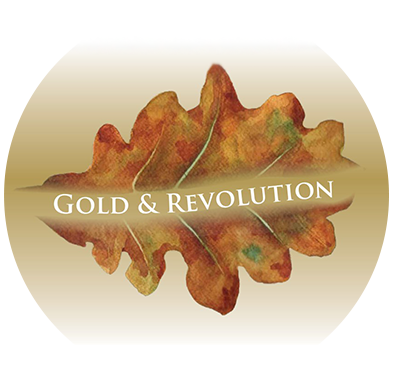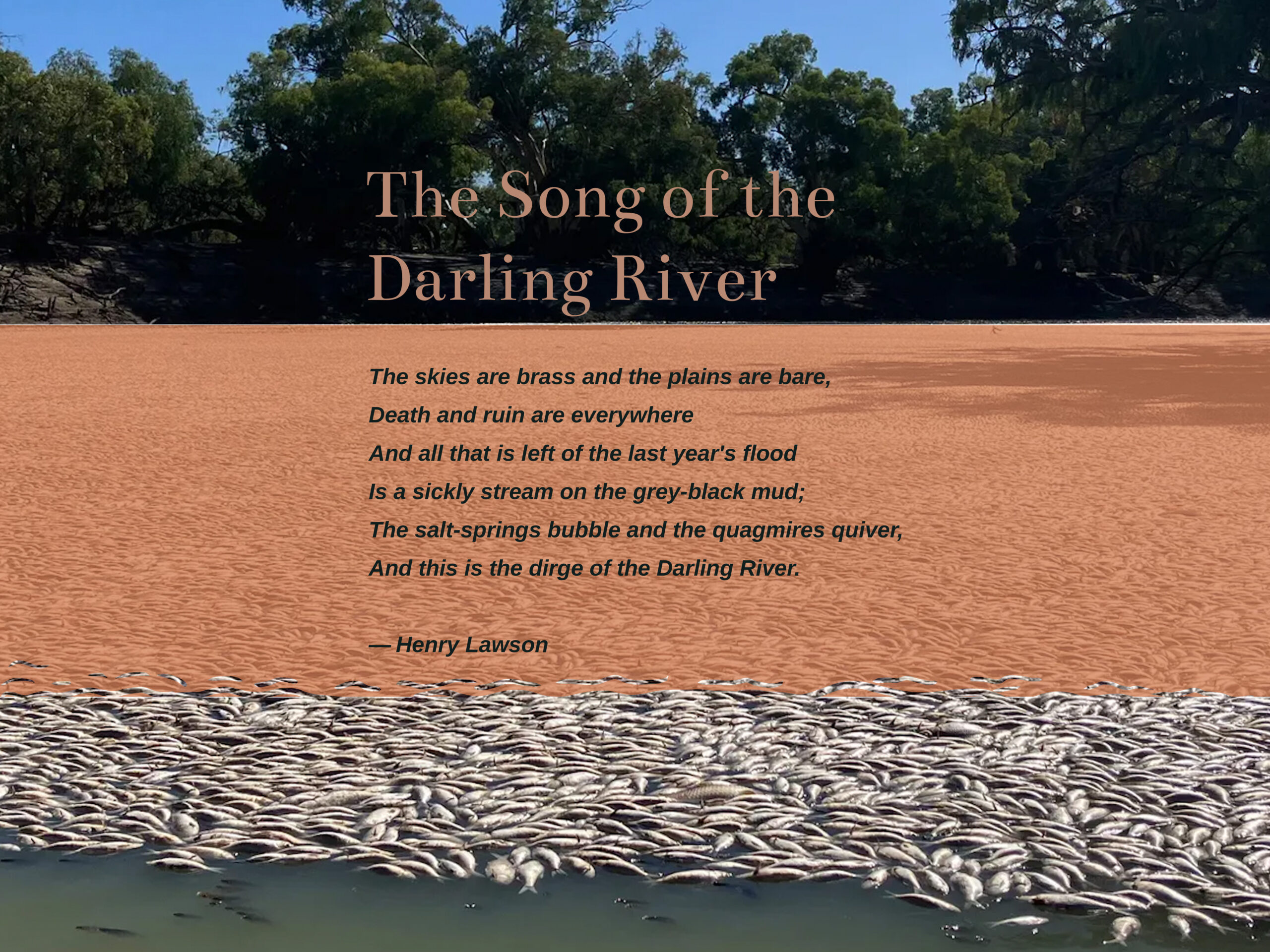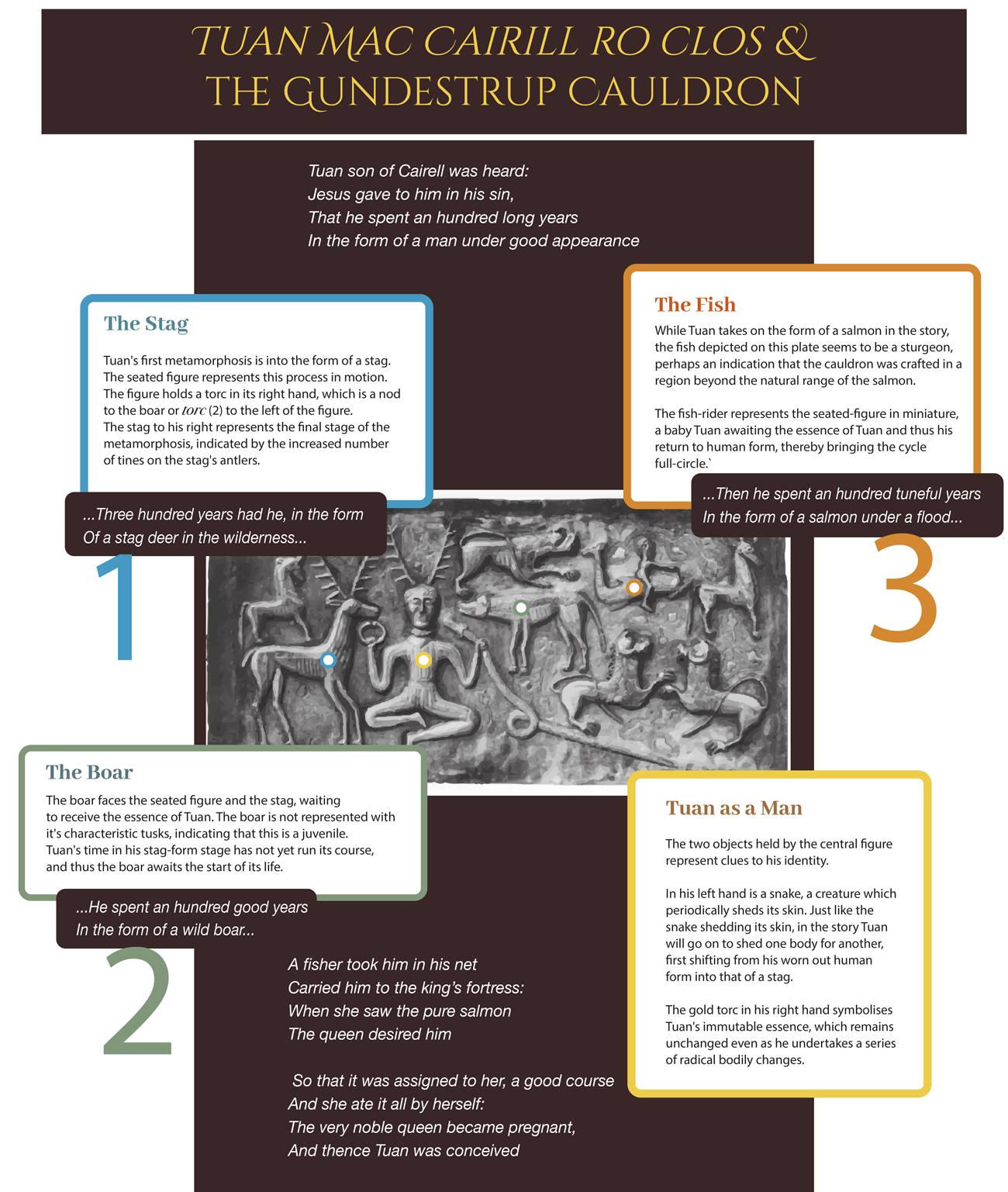…Gold and silver have, uninterruptedly to this day, continued to be the universal currency of the commercial and civilized world …
Jim Rickards, The Death of Money: The coming collapse of the International Monetary System
Is gold truly universal, as is reputed by gold enthusiasts such as Jim Rickards?
The universality of gold is a tenet of many precious metal advocates, who hold that the noble metals represent ‘true-money’, in stark contrast to modern fiat currencies. From their perspective, a return to the gold-standard is almost an inevitability, and most, like Jim Rickards, perceive the belief in gold to be ubiquitous.
It is this last claim, that of gold’s ubiquity, that we intend to reconnoitre here. Today, there is a powerful tool available that provides us with a test-lab to do exactly that.
In this article, we delve into the Google Trends website, reviewing all the ‘gold’ related search results from all countries around the globe that were run through the Google search engine starting from the year 2004, when Google first started to comprehensively capture such data, up to the year that has just ended, 2022.
Each country-specific result has then been re-ordered relative to the population of the jurisdiction, with the results recalibrated in order to create an effective visual representation of the data.
From this tweaked data, we have created a series of ‘heat maps’, which serve to highlight the countries and regions in the world in which the passion for gold would seem to run strongest.
But first, let us step back for a moment, so as to sound out the Google Trends website and provide an overview as to how it functions.
Google Trends: An outline
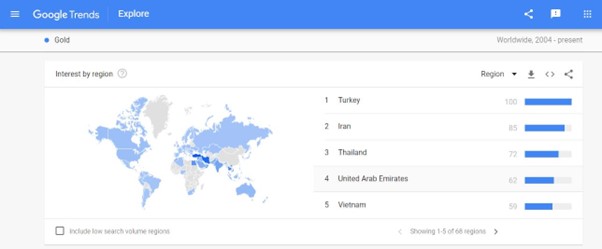
The website known as Google Trends was an initiative of the multinational technology company of the same name that was released with little fanfare in 2009. The site essentially tells users the frequency with which a word or phrase has been searched, based on locality and time period, starting from the year 2004.(1)
Google Trends allows users to conduct searches using either key words, or on a topical basis, as in the screen shot displayed above. Here, a search has been run on the topic of gold: Chemical element. (2)
Inputting a specific search term into Google Trends will limit the search to that exact term, however running a ‘search by topic’ into Google Trends will encompass all variants of searches for a topic, including those entered in different languages. Searches can be conducted on a worldwide basis, or on a more localised, country-specific basis.
After running a search through Google Trends, the site will display a chart as well as a list accompanied by a map, spotlighting countries or regions within a country, all of which are ranked in an ordered list.
This lineup is based upon a score that is generated by Google Trends for each country or region, ranging from 100, for the location that tops the list, down to 1.
The score allocated by Google Trends is relative to all of the searches from the particular location within a particular timeframe.
In theory, at least, this should mean that the Google Trend results should not display any tilt towards larger, more populous countries, by dint of their higher search volumes, although as is evident in the results depicted in the screenshot above, there is some reason to suspect that the theory may not always play out in practice.
The shortfalls of Google
It is important to note that Google Trends has some notable blind spots. The most glaring of these simply lies in the fact that the Google search engine is not used everywhere.
The biggest ‘black-hole’ for Google is in China, where Baidu is overwhelmingly the dominant search engine. Google is also a secondary player in Russia, although the gap between the leading Russian search engine, Yandex, and Google is not nearly so vast as the gulf between Google and its Chinese counterpart.
Unsurprisingly, Google Trends displays a strong bias towards areas where internet access is ubiquitous. Naturally, most Sub-Saharan African countries barely even register as a blip in the Google Trends data. Many people in these countries don’t have access to electricity, let alone internet connections.
For comparable reasons, it is problematic to compare a relatively poor developing country such as India with a developed country such as the United States. The Google Trends results are most meaningful when ‘apples’ are compared with ‘apples’.
Methodology
Our object here is to employ the data produced by Google Trends to create a number of ‘heat maps’ for the search topic of gold, highlighting regions where the Google searches run hot, and those areas where the searches for this topic are more muted.
However, because our aim is to convey this information visually, we have taken an extra step to further enhance the results, by dividing the Google Trends result for each country into the total population for the country.
This introduces a deliberate slant towards the smaller, less populous, and less expansive countries, which make up the lion’s share of countries in the world. As a result of this tweak, countries with small populations, but which rank strongly in the search lineup for ‘gold’ glow with a red-hot intensity on our map, whereas the handful of populous countries, which would otherwise dominate and overshadow the smaller nations, tend to fade off into the background.
In summary, the purpose of this ‘heat map’ is to highlight clusters of counties in which the passion for gold would seem to burn brightest, or at least according to Google Trends.
So, will the visualisation of these results test some widely held assumptions about the glittering metal? Let us take a peek at the first of our maps. We will start, naturally, by taking a step back, so as to take in a panorama of the wider world.
⊕ 1: The world of gold
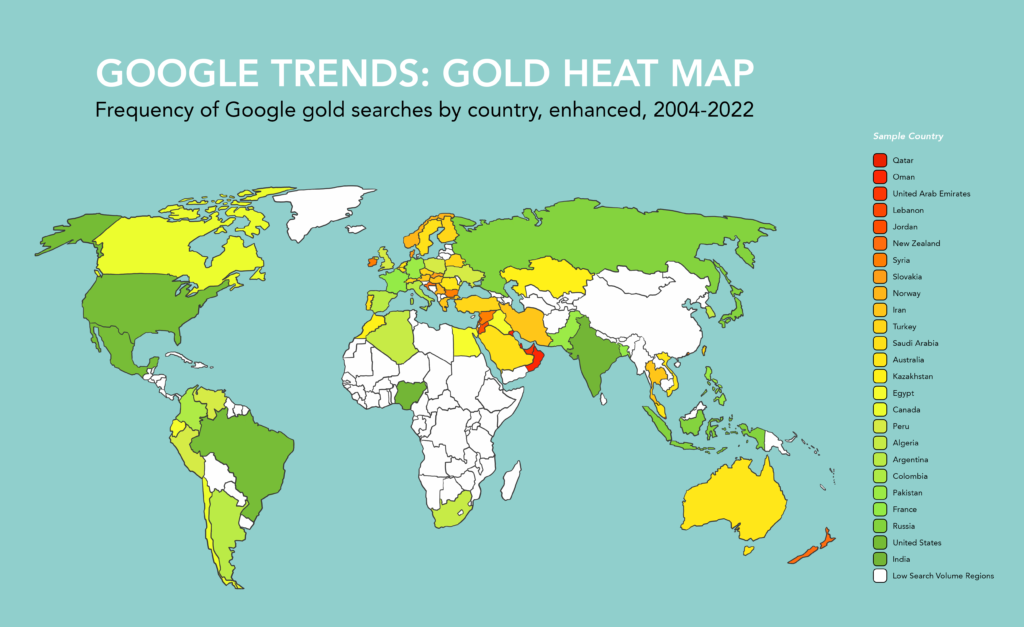
Our first map represents a graphical visualisation of all the Google searches from across the globe on the topic of gold, starting from 2004, the earliest date made available by Google Trends, up to and including the most recent year, at time of writing, 2022. As noted above, the results have been enhanced for greater visual clarity.
Even at a glance, the red-hot heart of Google gold searches becomes immediately apparent. The ‘hot-spots’ for gold are in the Middle East, and especially in the south-eastern corner of the Arabian peninsula.
If Google gold searches can be taken as a gage of the level of interest in gold in a particular jurisdiction, it would seem that the nations of Qatar, Oman and the United Arab Emirates win hands down, with a number of other nearby countries hot on their heels.
But what can we deduce from this? Why do these few countries lead the pack in the gold stakes?
The simplest, if glaringly obvious, explanation relates to wealth, or more specifically, the measure of GDP per capita on a purchasing power parity basis. This measure, more or less, determines the GDP of a country broken down to a per person basis.
Qatar and the UAE, for example, are both countries that score highly on this GDP per capita measure, and with more money sloshing around in these nations, the logical inference is that people living in these countries would have both the means and inclination to pursue gold purchases, leading to a greater frequency of google searches for gold in these countries.
But while GDP per capita is certainly one factor that is evident in the rankings, it is not the single most important factor. This becomes apparent when we look at some of the other ‘hot spots’ in the Middle East.
Jordan, nestled on the northern edge of the Arabian desert, is a case in point. Jordan is a relatively poor country, with a GDP per capita well below the global average, and not much higher than that of the Philippines. And yet, despite the considerable handicap of a low GDP per capita, on our rankings, Jordan manages to make it into fifth place.
So while GDP per capita influences the relative position of a country in the Google Trends rankings, there are clearly other, more powerful influences at play here.
That so many of the hot-spots on our map are found clustered around the Arabian peninsular may be a strong indication that cultural factors have a hand in shaping the burning desire for gold in this corner of the World.
Could this be related to religion? Arabia, of course, represents the cradle of Islam, and the peninsula is home to the sacred cities of Mecca and Medina. So it is a live possibility.
However, the skew in the results to the south-east of Arabia might suggest that the passion for gold that is evident in the results from this region probably harks back to a pre-Islamic age.
Three of the countries that top our leaderboard, Qatar, Oman and the UAE, are cut off from the rest of the world by the vast Arabian desert to the north-west, and by stretches of ocean to the north and the east.
Such obstacles have served as formidable protective barriers for the inhabitants of these lands for thousands of years, hindering the advance of rapacious invaders such as the Romans in Ancient times, the Mongols in the Middle Ages, or the Ottomans of Early Modern times.
As such, ancient cultural belief systems – such as the passion for gold- were hermetically sealed within this sheltered corner of Arabia, and it is this ancient footprint that seems to be being picked up by the Google Trends results in the 21st century.
Or at least, it is a plausible theory. But one swallow does not a summer make.
That said, there are some other indicators displayed on the map that might add further weight to the suggestion that the gold search results are most concentrated in certain areas of the globe where the belief in gold is very ancient.
One pattern evident on our world map in particular adds some clout to this idea. It is notable that across the Americas, searches for gold on Google are relatively muted, notwithstanding fact that many American countries are major producers of precious metals.
That the ‘New World’ countries of the Americas seem to be markedly less passionate about gold would seem to accord with the notion that the belief in gold is concentrated in specific ‘Old World’ zones, for cultural and historical reasons.
While this is strongly suggested by the patterns we find displayed on the global map, the patterns on more localised maps also appear to reflect this paradigm.
In our next map, we zero in on a specific region, Europe.
Here, we will seek out further evidence to determine if the thesis that the desire for gold is driven by ancient cultural forces continues to carry traction.
⊕ 2: Europe’s goldlands
In Europe, we find a distinctive east-west divide on the gold front, although some exceptions to this pattern are found in the northern Atlantic fringe.
In general, the patterns on display in Europe would seem to be in keeping with the idea that the passion for gold is not ecumenical, but rather, rooted in particular cultural zones.
This is evident through a comparison of a series of analogous countries, three of them in the north, and three further to the south.
In Northern Europe, the affluent nations of Ireland, Denmark and Finland all have comparably-sized populations, with all three falling between the five-to-six million mark.
And yet, as is evident on the map below, the pattern of gold searches in each country is markedly different: The Danes and the Irish would seem to be distinctly more enthusiastic about seeking out information on gold in Google, in comparison to the Finns. In the north of Europe, thus, there would seem to be a westerly bias, with interest in gold seemingly strongest in the Atlantic-facing nations.
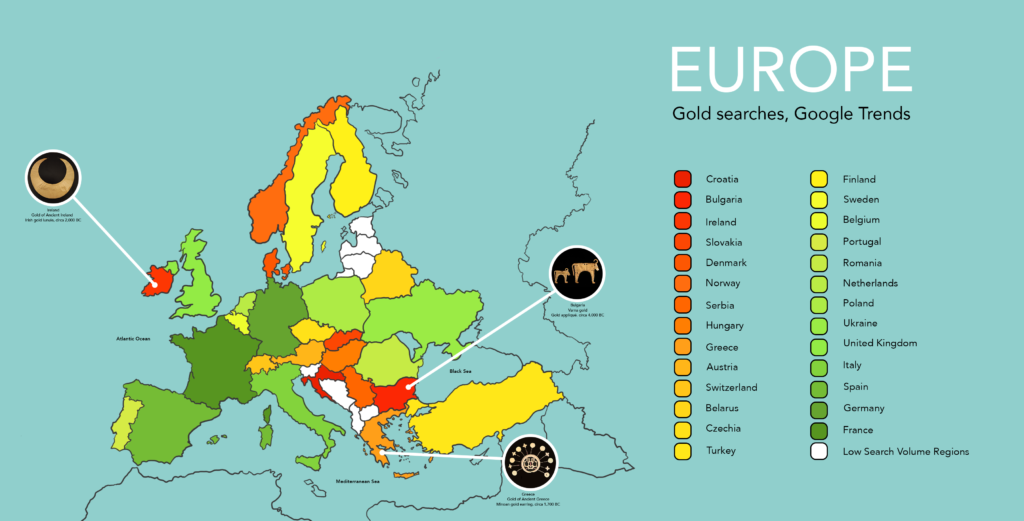
This pattern, however, would seem to go into reverse in the southern half of Europe. Here, the interest in gold registers most acutely in eastern Europe.
Let us, once again, compare three countries of comparable size: Portugal in the west of Europe; Czechia, in the heart of Europe; and Greece, in the east.
All three nations have populations falling between the ten-to-eleven million mark, and yet the Greeks seem to possess a more avid interested in gold than the Czechs, and much more so than the Portuguese, who, in our rankings, sit well below the Czechs. This is despite the fact that the average Greek is poorer than the average resident of Portugal or Czechia.
The differences we see here would surely have to be an outgrowth of cultural factors. Some of the ancient lust for gold that was possessed by the Minoans and Mycenaeans in ancient times would appear to have rubbed off on the Greeks in modern times, or so it would seem.
However, on this map of Europe there are two countries, as of yet unmentioned, that stand head-and-shoulders above all the rest. We will turn to these leading lights now.
Bulgaria and Turkey
Bulgaria is by no-means a wealthy country: on a GDP per capita basis, the country is ranked even lower than Greece.
And yet, this relatively poor European country seems to be the red-hot heart for Google gold searches in Europe, with only Croatia pipping it at the post.
As was noted above in the example of Greece, the European results seem to have a eastward skew, and the Bulgaria and Croatia results would seem to conform to this pattern. But why these two specific countries?
Croatia, with less than four million people, is a relatively small country in terms of population, and as the data used to create these maps has been deliberately tilted to spotight the smaller countries, Croatia has probably been handed a bit of a leg-up.
This is, however, not true for Bulgaria, a larger country than Croatia, with a population of over six million, and poorer to boot. Bulgaria, in other words, stands out as something of an anomaly in the region.
As with the Arabian countries, Bulgaria’s stand-out result most likely boils down to cultural and historical factors.
The modern-day territory of Bulgaria was once home to the ancient Varna culture, who, around six and a half thousand years ago, resided in the east of Bulgaria, near the shores of the Black Sea. That these Varna-folk held gold in high esteem is evident from numerous golden artefacts that have been unearthed from the ancient necropolis of the Varna, first discovered in the 1970s.
Clearly, the Varna adored gold, and may well have been the first culture in the world to do so. The golden artefacts unearthed from the Varna cemetery are reckoned to be the oldest in Europe, if not the world.(3)
It is fascinating that, assuming we can have faith in the verity of the Google Trend results, Bulgarians of the present day seem to be as mad for gold as the ancient Varna were.
The example of Bulgaria would seem to highlight the influence of ancient cultural belief systems in shaping modern-day infatuations. But one other stand-out country on this map of Europe lends further support to this line of argument.
Because these maps are designed to highlight smaller countries, the larger, more populous countries tend to wane into the background, fading away into various languid hues of green. As expected, most of the largest countries in Europe -Germany, France, Italy- fade off into shades of green.
But there is one conspicuous exception: Turkey, one of the largest countries in Europe, on par with Germany in terms of population.
Despite its vast size, Turkey sizzles like sand on a summer’s day on our heat map, glowing, aptly enough, in a resplendent golden-yellow hue.
As in the case of Bulgaria, precious metals were prized in Turkey in ancient times. The earliest known minted coins are associated with the kingdom of Lydia, which dominated the Turkish region of Anatolia, and Midas, the legendary king remembered in Greek myth for his golden touch, ruled over the kingdom of Phrygria, in the same region in an earlier age.(4)
The ancient passion for gold here seemingly still burns as strongly today, as it did in the days of King Midas.
We are left now to ponder a puzzle missing a piece. If the passion for gold is concentrated in those parts of Europe and Asia in which the brilliant metals has always been highly regarded, as our maps would seem to indicate, why is it that gold has come to be so widely perceived as a valuable commodity across the globe?
In our final map, we will seek to find an answer to this question. We will conclude our study by shifting focus from the big picture, to one much smaller, seeking an answer in a young country on the very edge of the world.
⊕ 3: New Zealand’s gold divide
When it comes to Google searches and gold, New Zealand stands as a curiosity. A keen interest in gold from this corner of the globe is evident from a cursory glance of our world map, but the nation is a geographically remote outlier, far from the gold heartlands of Eurasia.
As will be demonstrated below, a closer inspection of the pattern of search results specific to this jurisdiction reveals that here too, there are likely historic factors at play that may serve to explain the discrepancy.
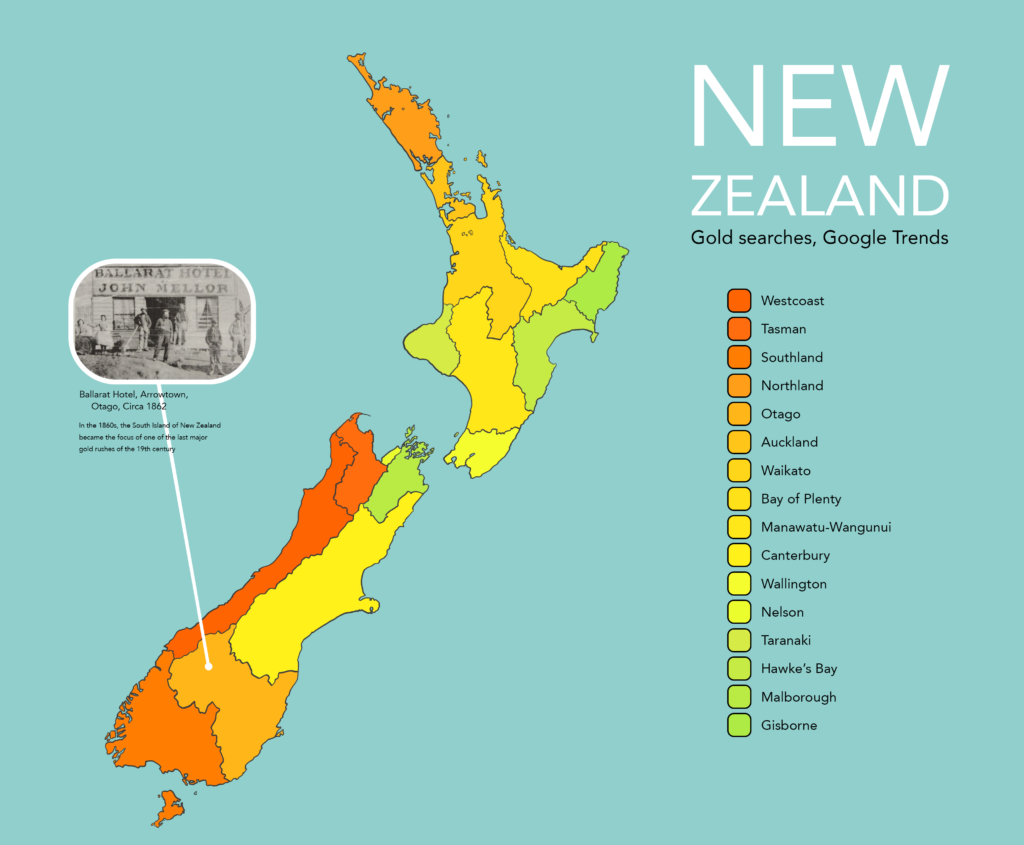
At a casual glance, the heat map displayed here indicates that the searches for gold-related topics in New Zealand is concentrated in the South Island, and particularly along the west coast.
This pattern is in keeping with the movements of migrants of the gold-rush era, who, over one hundred and fifty years ago, were lured to the South Island by the promise of riches.
After gold was discovered in California in 1848, and subsequently in Australia in 1851, New Zealand’s southern isle was next in line for a gold frenzy, which duly commenced when the Tasmanian prospector Gabriel Read discovered gold in the far south of Otago in 1861.(5)
As the focus of one of the last major gold rushes, the South Island of New Zealand proved to be the last stop for many avaracious adventurers.
Successive waves of migrants rushed first to California, followed by south-eastern Australia, but ultimately, many of the most determined fortune-hunters of this era eventually ended their days washed up in the South Island of New Zealand. New Zealand, thus, represented a last throw of the dice for those who had lucked-out in the United States and Australia.
The gold-fever that infected these gold rush era migrants would seem to have been passed on to the descendants of these luckless gold-chasers, if we can take the intensity of the Google gold related search results from New Zealand’s southern isle as a guide.
But the patterns displayed on our map provide us with some reason to suspect that one group of gold-rush migrants in particular may have had a disproportionate influence on shaping the modern day passion for gold in the south.
There are two regions in the South Island that lead the pack on the Google Trends scorecard, evident on this map from the toasty-warm orange strip that runs along the west coast of the island, approximating to the modern local government regions of Westcoast and Tasman.
These western, coastal regions of the southern island attracted an unusually large number of Irish women in the heady days of the gold rush.
Census figures from the region indicate between 1867 and 1896, as many as one-third of female migrants living in the region had been born in Ireland. However, the female immigrant population of Irish background was far higher than this, as the census results do not account for the fact that many of the female immigrants from Australia who migrated to New Zealand in this period were of Irish parentage, as were lesser numbers of the female British migrants.(6)
This might suggest the strong passion for gold in the western regions of New Zealand’s South Island is connected to the many Irish female gold-rush migrants who migrated to this region in the late 19th century.
As was evident in the heat map of Europe, the enthusiasm for gold would seem to run strong in Ireland, and on the face of it, it would seem that some of the Irish fervour for gold found its way to the South Island of New Zealand, and especially the western coast.
In other words, the passion for gold would appear to have been transplanted from Ireland to the South Island of New Zealand, and then passed down from mother to child, from one generation to the next, until the present day.
New light on an old riddle
Our graphical representations of the ‘gold’ data accumulated by Google Trends over the eighteen year period from 2004 to 2022 challenges some ingrained assumptions about the universality of gold.
As outlined above, the patterns displayed on these ‘heat maps’ would seem to indicate that the passion for gold is most keenly felt in the parts of the world where it has always been cherished.
Arabia here is a standout, but both Turkey and Eastern Europe, and most notably Bulgaria, also appear to be hotbeds for gold (or more specifically, for searches of auriferous-related terms in Google, though we can reasonably assume that such searches are reflective of a genuine interest in gold).
What is fascinating about Bulgaria and Turkey is that the archaeological record makes it clear that in both of these lands, the love of gold stretches back thousands of years. The hold of gold over the collective imagination of Bulgarians and Turks does not seem to have dimmed, notwithstanding the passage of millennia.
The tenacity of this ancient belief in such regions might suggest that the belief in gold may be primarily harboured within the female half of the population. Women historically tend to be less transitory than men, and given their role as the primary caregivers for the young in traditional societies, they would be aptly placed to impart their ardour for gold down to successive generations.
This leads to the question as to how the belief in gold spread from beyond these ancient hubs. However, the answer to this question might perhaps also be buried within the Google search data.
It is possible that gold-rushes might serve as vectors for the propagation of the belief in gold into new territories. The concentration of gold-searches in the western areas of New Zealand’s south island might ultimately harken back to the large number of Irish women who settled in this region during the gold-rush era, effectively transplanting an Old World belief into a new one.
While the results of this heat map would seem to somewhat challenge the notion that gold is held in universal esteem, the findings of this study also throw up some other interesting questions, one of which will be broached in closing.
It is intriguing that the passion for gold seems to be particularly concentrated in lands associated with the ancient belief system known as hermeticism, a mysterious philosophy that originates in the shadowlands between history and myth.
The name of this philosphy derives from the name of a legendary figure of Greek mythology, Hermes Trismegistus, who is associated with various mysterious occult texts, and with alchemy in particular.
The figure of Hermes Trismegistus occurs across many different cultures, albeit under different guises. To the ancient Egyptians, Hermes was known as Thoth; to the Hebrews, Enoch; and to the Medieval Muslims, Idris.
It is notable the geographic centres of Hermetic beliefs, the Middle East and Eastern Europe, seem to overlap with geographies where the Google searches for gold are at their most intense.
Is there some connection between the gold-lands of Google and this mysterious and ancient belief system?
It is a question worthy of further exploration, and one that we hope to return to at some later time.
Footnotes
(1) Stephens-Davidowitz, S, 2017, everybody lies: What the Internet Can Tell Us About Who we Really Are, New York: HarperCollins, p 3
(2) Rogers, S, 2016, What is Google Trends data – and what does it mean?, Google News Lab, accessed 3 January 2023 <https://medium.com/google-news-lab/what-is-google-trends-data-and-what-does-it-mean-b48f07342ee8> (view link).
(3) Leusch, V, Armbruster, B, Pernicka, E and Slavcev, V, 2015. On the Invention of Gold Metallurgy: The Gold Objects from the Varna I Cemetery (Bulgaria)- Technological Consequence and Inventive Creativity. Cambridge Archaeological Journal, 25, p. 353-376, accessed 3 January 2023, (view link)
(4) Papadopoulos, J, 2012, Money, Art, And the Construction of Value in the Ancient Mediterranean, The Construction of Value in the Ancient World, The Cotsen Institute of Archaeology Press, Los Angeles, p 268-69
(5) Brett, A, 2016, Acknowledge No Frontier: The Creation and Demise of New Zealand’s Provinces, 1853-76, Otago University Press, Dunedin, p 116.
(6) Carpenter, L and Fraser, L, 2016, Rushing for Gold: Life and Commerce on the Goldfields of New Zealand and Australia, Otago University Press, Dunedin, p 177-78
